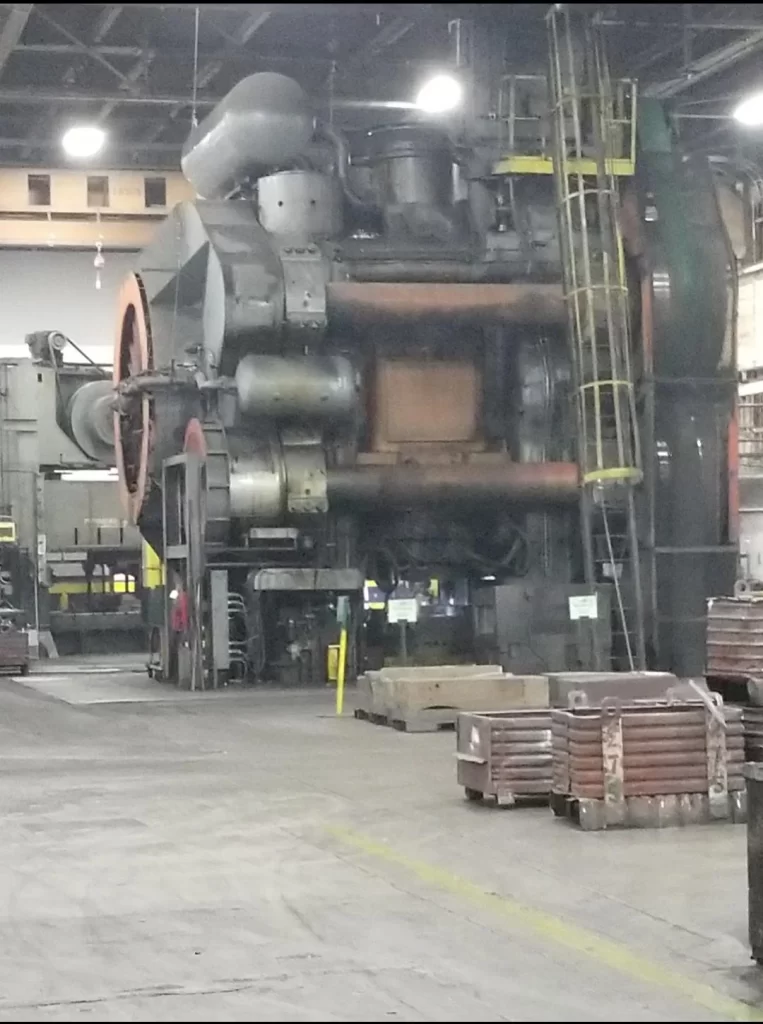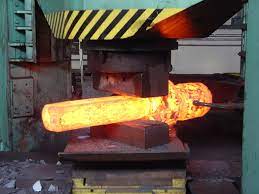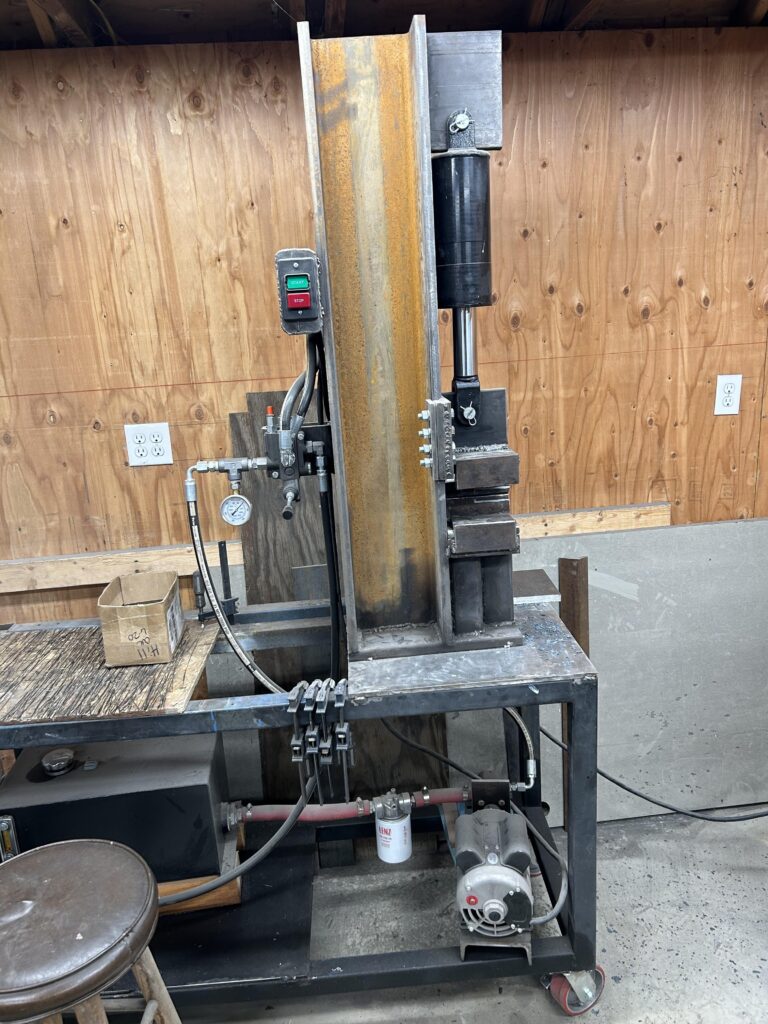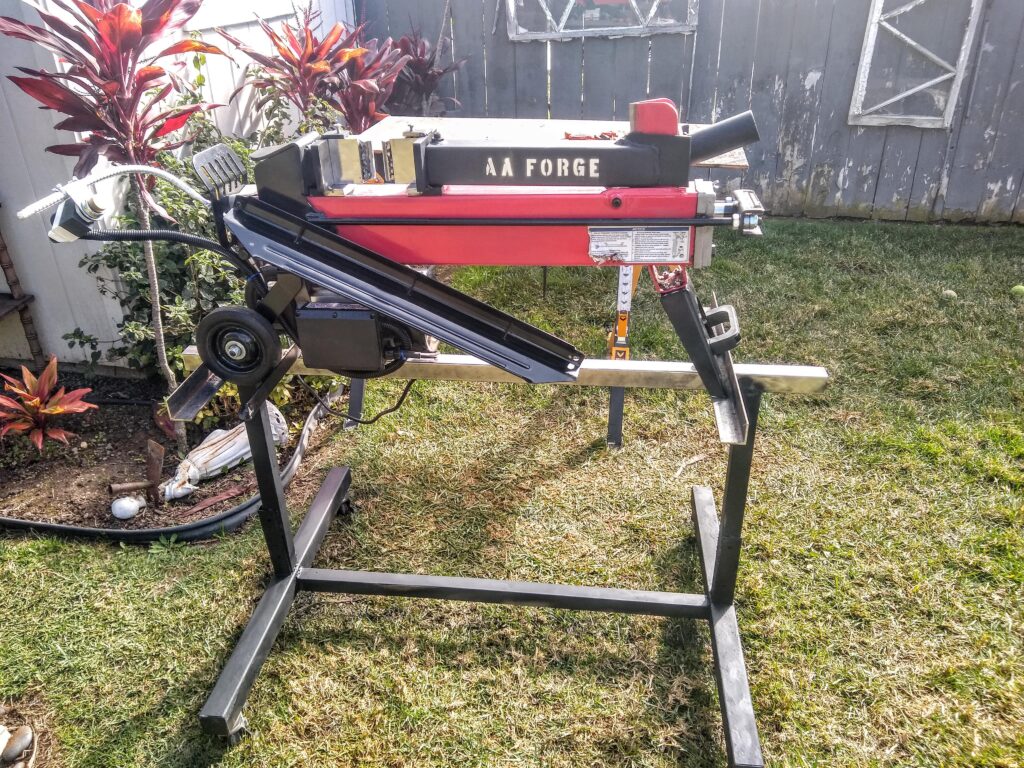Intro to the Forging Press
Forging has been shaping the course of human history, literally molding the metal foundation of our industrial advancements. From ancient blacksmiths to today’s high-tech industries, the transformation of metal into functional and structural objects is a craft that remains vital.
This post will delve into the fascinating world of forging press technology, exploring everything from the basic mechanics to the latest innovations.
Whether it’s a small forging press for custom creations or large-scale hydraulic presses for industrial needs, understanding the capabilities and applications of different forging presses is crucial for anyone involved in metalworking.
The process of metal forging is not just about brute force; it’s a nuanced art that combines strength with precision. Today, forging presses are central to this process, allowing us to produce everything from the simplest tools to complex components for aerospace and beyond.
We’ll explore the dynamics of open forging, the precision of open-die forging, and the power behind hydraulic press forging.
By understanding these technologies and how they’re applied across various industries, you’ll gain insight into how the right forging press can significantly impact the quality and efficiency of metalworking projects.
Understanding Forging Press Mechanics

Forging presses are powerhouse machines used to shape metal through the application of compressive forces. At their core, these presses transform metal blanks into precise shapes by pressing them between two dies that contain the desired shape.
This method is fundamental in creating parts that are strong, durable, and capable of withstanding extreme conditions.
There are primarily two types of forging presses: mechanical and hydraulic. Mechanical presses operate through a motor-driven flywheel that stores energy, transferring it through gears and clutches to drive the press down.
This setup excels in speed and is often used for high-volume production runs. Hydraulic presses, on the other hand, rely on hydraulic fluid pressure to generate force.
This system allows for more precise control over the pressing force and speed, making hydraulic presses ideal for complex shapes and materials that require a more delicate touch.
The choice between mechanical and hydraulic presses depends on specific project requirements, including the material being forged, the complexity of the shape, and production volume.
Contact us: service@drsengineering.ae for any equipment or service needs.
The Power of Open Forging
Open forging, also known as open die forging, is a process where metal is deformed between multiple dies that do not completely enclose the material.
Typically used for shaping large pieces of metal, open forging involves hammering or pressing the metal between two open dies that move together to mold the metal into the desired shape. This method is particularly effective for creating large, simple shapes like rings, discs, shafts, and beams.
One of the main advantages of open forging is its versatility. It allows for the production of a wide range of shapes and sizes, accommodating very large parts that closed die forging can’t handle due to size limitations.
Open forging also enhances the strength and durability of the metal by refining its internal grain structure, resulting in superior mechanical properties and resistance to fatigue and impact.
Materials commonly used in open forging include a variety of metals such as carbon steel, alloy steel, stainless steel, aluminum, titanium, and more. Each material offers unique properties that make it suitable for specific applications, from aerospace and automotive components to industrial machinery and tooling.
The choice of material depends on the requirements of the final product, including strength, corrosion resistance, and thermal conductivity.
Open Die Forging Explained

Open die forging, often referred to as free forging, involves deforming a piece of metal between multiple dies that do not entirely encase the material. This process allows for the manipulation of large, simple or complex shapes by hammering or pressing the metal.
The dies, which are open on the sides, are brought close together but never actually enclose the metal, allowing it to flow outside the die shapes.
This method is particularly effective for producing large pieces and components such as shafts, rings, blanks, and bars, which are foundational in industries like aerospace, energy, and heavy machinery.
Open die forging is favored for its ability to strengthen the material by refining its internal grain structure, enhancing durability and resistance to impact and fatigue. It’s ideal for custom or unique pieces and for materials that require specific mechanical properties.
However, the process can be more time-consuming and may require more material and machining to achieve the final dimensions and surface finish compared to closed-die forging.
Closed-die forging, in contrast, involves metal being placed in a mold attached to an anvil. When the hammer strikes, the metal flows and fills the mold cavities.
The die shapes completely enclose the material, resulting in a closer approximation to the final product shape, reducing the need for post-forging machining. This method is highly efficient for mass production of components with intricate shapes, like automotive, agricultural, and hardware parts.
Closed-die forging offers higher dimensional accuracy and less material waste than open die forging.
The choice between open and closed-die forging ultimately depends on the project requirements.
Open die forging is preferred for larger, custom pieces that benefit from the improved structural integrity provided by the forging process, while closed-die forging is suited for high-volume production of parts with complex shapes and tighter tolerances.
Also Read: The Copper Rod Guide
The Role of Hydraulic Presses in Forging

Hydraulic presses play a pivotal role in the modern forging industry, thanks to their ability to apply a controlled force ranging from a few tons to thousands of tons. This versatility makes them indispensable for a wide range of forging applications.
The core principle behind hydraulic presses involves using a hydraulic cylinder to generate a compressive force, which facilitates the deformation of metals into desired shapes and sizes.
One of the key advantages of hydraulic presses in forging is their ability to deliver uniform pressure across the entire surface area of the die. This uniform application of force ensures consistent quality in the forged parts, with minimal internal defects.
Moreover, hydraulic presses offer the benefit of precise control over the forging process. Operators can adjust the pressure and stroke of the press according to the specific requirements of the piece being forged, allowing for high precision in the shaping process.
Hydraulic technology also enables slower, more controlled pressing speeds, which is particularly beneficial for complex or intricate forging tasks.
This controlled pressing can reduce the likelihood of errors, enhance material properties through better grain structure, and improve the overall quality of the finished product.
Additionally, hydraulic presses are known for their efficiency and energy-saving capabilities. They typically consume less energy compared to mechanical presses, especially when operating at lower speeds.
This efficiency, combined with their versatility and precision, makes hydraulic presses a preferred choice for many forging applications, from small-scale workshops to large industrial settings.
In summary, hydraulic presses significantly contribute to the forging industry by offering uniform pressure application, precise control, efficiency, and versatility. Their role is crucial in producing high-quality forged components that meet the rigorous standards of various industries.
Differentiating Forging Pressing Techniques
Forging pressing stands out as a metalworking process due to its unique approach to shaping metal through the application of compressive forces. Unlike casting, where metal is melted and poured into molds, forging pressing deforms the metal while in a solid state, often heated to increase plasticity.
This technique contrasts with machining, where material is removed to shape a part, by instead using pressure to mold the metal into the desired form.
In forging pressing, there are two primary techniques: closed-die forging and open-die forging. Closed-die forging involves metal being placed in a die resembling the part’s final shape, applying pressure to fill the die’s contours, perfect for mass-producing components with precise dimensions.
Open-die forging, on the other hand, doesn’t confine the metal in detailed molds, allowing for the creation of larger, more versatile shapes that can be further refined through machining.
Products created through forging pressing are varied and find applications across numerous industries. Automotive and aerospace sectors rely on the strength and reliability of forged parts such as gears, levers, and engine components.
In the construction and mining industries, forged items include heavy equipment components, bolts, and connectors, benefiting from forging’s enhanced structural integrity.
The distinct advantage of forging pressing over other metalworking processes lies in the improved mechanical properties it imparts to metal parts.
The deformation process refines the metal’s grain structure, aligning it with the part’s shape, which enhances strength, ductility, and resistance to impact and fatigue.
These properties are crucial for components subjected to high stress and demanding environments, making forging pressing an essential technique in manufacturing durable, high-performance metal parts.
Also Read: What is a Smelter
Scaling Down: The Small Forging Press

Small forging presses play a pivotal role in boutique or small-scale operations, where the production volume might not justify the use of larger, industrial-scale equipment.
These compact presses offer versatility and accessibility, making them an invaluable asset for artisans, custom part manufacturers, and startups exploring niche markets or specialized products.
The benefits of small forging presses extend beyond their size. They provide precision and control, essential for creating detailed or unique items that demand a high degree of customization.
Additionally, their lower operating costs, including reduced power consumption and space requirements, make them a cost-effective solution for businesses with limited resources.
When selecting a small forging press, several factors merit consideration to ensure the tool meets the specific needs of the operation. Firstly, assess the press’s capacity and ensure it aligns with the materials and the scale of products intended for production.
Durability is another critical factor; a robustly constructed press can handle repeated use without compromising performance. Ease of use and maintenance should also influence the decision, especially for businesses with limited technical support.
Moreover, considering the press’s adaptability to various tasks can enhance its utility, making it a more valuable investment. For instance, some small forging presses offer interchangeable dies or attachments, enabling a broader range of operations without needing multiple machines.
For small businesses or individual metalworkers venturing into the world of metal forging, investing in a small forging press can be a strategic decision that balances capability with economy.
It allows for the exploration of creative designs and custom fabrication, opening up opportunities in markets where uniqueness and craftsmanship are highly valued.
Careful selection based on the operation’s specific requirements ensures that the chosen press will be an effective and efficient tool in realizing their metalworking ambitions.
Choosing the Right Forging Press for Your Needs
Selecting the right forging press is crucial for efficiency, productivity, and quality in metalworking projects. Here are essential guidelines to consider when choosing a forging press that aligns with your needs:
- Understand Your Project Requirements: Clearly define what you intend to forge, including the types of metals and the complexity of the designs. This understanding will guide your choice between open-die, closed-die, and other specialized forging processes.
- Consider the Scale of Production: Your production volume greatly influences the type of press you need. High-volume production might benefit from a hydraulic press for its speed and efficiency, whereas small-scale projects might do well with a mechanical press for its precision and lower cost.
- Evaluate Material Specifications: Different materials have varying resistance to deformation. Heavier, more durable materials may require a press with higher force capabilities. Ensure the press you choose can handle the specific materials you plan to work with.
- Assess End Product Specifications: Consider the size, shape, and tolerance levels of your desired end products. For intricate or highly detailed items, a press that allows for greater control and fine adjustments might be necessary.
- Budget and Space Considerations: Beyond the initial purchase price, consider the operational costs, including power consumption, maintenance, and space requirements. Ensure you have the necessary space for the press and any ancillary equipment it may require.
- Technological Features and Upgradability: Look for presses that offer the latest technological advancements to enhance efficiency and quality. Also, consider the potential for upgrades to ensure your press can evolve with changing business needs.
- Manufacturer’s Reputation and Support: Choose equipment from reputable manufacturers known for quality and durability. Additionally, consider the level of technical support and service offered. Having access to prompt maintenance and repair services can significantly reduce downtime.
By carefully evaluating these factors, you can select a forging press that not only meets your current requirements but also accommodates future growth and changes in production needs. Investing time in this decision-making process ensures that you acquire a press that contributes to the success and sustainability of your forging projects.
Also Read: What is ControlNet and DeviceNet
Innovations in Forging Press Technology
The forging industry has witnessed significant technological advancements in press design, significantly impacting both efficiency and product quality. Here are some of the key innovations:
Servo Technology: Modern forging presses are increasingly equipped with servo technology, allowing for unparalleled control over the forging process. This innovation enables precise adjustments in stroke, speed, and pressure, which results in higher precision in forged parts and reduced material waste.
Automated Control Systems: Advanced control systems have been integrated into forging presses, enabling automated operation and monitoring. These systems provide real-time data analysis, predictive maintenance alerts, and process optimization suggestions, leading to increased operational efficiency and reduced downtime.
Energy Efficiency Improvements: New forging press designs focus on energy conservation, incorporating features such as regenerative braking and energy recovery systems. These technologies not only reduce the carbon footprint of forging operations but also lower operational costs by minimizing energy consumption.
Hybrid Presses: The development of hybrid forging presses, which combine the power of hydraulic presses with the speed and efficiency of mechanical presses, represents a leap forward in forging technology. These presses offer the best of both worlds, providing high force capabilities with faster cycle times.
3D Printing and Additive Manufacturing Integration: Some forging presses now integrate with additive manufacturing processes, allowing for the creation of near-net-shape preforms that significantly reduce material waste. This integration streamlines the production process, enhances material utilization, and enables the forging of complex geometries with improved accuracy.
Internet of Things (IoT) and Connectivity: IoT technology has made its way into forging press design, facilitating better connectivity between equipment and operational systems. This connectivity enables predictive analytics, remote troubleshooting, and seamless integration into Industry 4.0 manufacturing environments.
Enhanced Safety Features: Modern presses are equipped with sophisticated safety systems, including light curtains, pressure-sensitive mats, and advanced emergency stop mechanisms. These features protect operators from accidents and ensure compliance with stringent safety regulations.
These innovations in forging press technology not only elevate the efficiency and productivity of forging operations but also significantly enhance the quality of the final products.
By adopting these advanced technologies, manufacturers can stay competitive in a rapidly evolving industry, meeting the growing demand for high-precision, high-quality forged components.
Contact us: service@drsengineering.ae for any equipment or service needs.
Concluding our Guide to Forging Press Tech
In conclusion, mastering the intricacies of forging processes and equipment is vital for anyone involved in the metalworking industry.
The choice of the right forging press—be it hydraulic, mechanical, or utilizing the latest innovations—can significantly influence the efficiency of production, the quality of the final product, and the overall operational costs.
Understanding the specifics of open die and closed-die forging, along with the capabilities of various forging presses, is essential for making informed decisions that align with your project’s requirements.
As you venture into your next project, take the time to assess your needs against the backdrop of the latest advancements in forging technology.
Whether you’re running a large-scale operation or a boutique workshop, the selection of appropriate forging equipment or the decision to order custom-forged parts requires a thorough understanding of these processes.
Let this guide be a stepping stone in your journey towards achieving excellence in metalworking, and don’t hesitate to delve deeper into the community and resources available to refine your craft and ensure your projects’ success.

